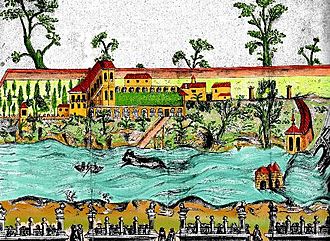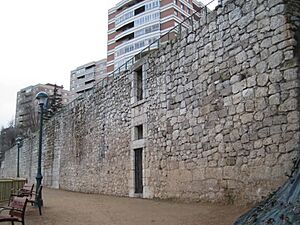Palacio de la Ribera facts for kids
Quick facts for kids Palacio de la Ribera |
|
|---|---|

Palacio de la Rivera. Drawing by Ventura Pérez (c. Early Modern ages)
|
|
| Alternative names | Palace of the Bank |
| General information | |
| Type | Palace |
| Architectural style | Renaissance |
| Town or city | Valladolid |
| Country | Spain |
| Construction started | 1602 |
| Completed | 1605 |
| Demolished | 1761 |
| Design and construction | |
| Architect | Francisco de Mora Diego de Praves |
| Structural engineer | Bartolomé de la Calzada |
| Civil engineer | Juan de Nates |
The Palacio de la Ribera (also called "Palace of the Bank") was a special summer home for King Philip III in Valladolid, Spain. It was built between 1602 and 1605. This palace was part of a big plan to change the city when the Spanish royal court moved to Valladolid from 1601 to 1606.
The palace was located in an area called Huerta del Rey, which means "King's Orchard." It was right by the Pisuerga river, across from a park called Parque de las Moreras. The palace and its grounds stretched from one bridge (Puente Mayor) to another area called Ribera de Don Periáñez del Corral. It was bordered by the river on one side and a path (Camino del Monasterio del Prado) on the other. Over time, people stopped using the palace. It was finally torn down in 1761, becoming a lost piece of history in Valladolid. Today, only a few ruins of the building remain.
Contents
Building the Royal Summer Palace
The idea for the Palacio de la Ribera came from Don Francisco Gómez de Sandoval y Rojas, the Duke of Lerma. He was a very important person who convinced King Philip III to make Valladolid the capital of Habsburg Spain in 1601. This was a big change from what the previous king, Philip II, had wanted.
The Duke of Lerma bought the land for the palace first. It was known as the "Duke's Orchard" (Huerta del Duque) before it became the "King's Orchard" (Huerta del Rey).
Design and Construction of the Palace
Work on the new summer palace started in 1602. The main architect was Francisco de Mora. Other architects like Diego de Praves, Juan de Nates, and Bartolomé de la Calzada might have helped too. The goal was to create a fun, relaxing place for the king and his court. It was meant to be different from the serious Royal Palace of Valladolid, where official government business happened.
Architect de Mora turned a simple country house into a fancy place for fun and enjoying nature. It was designed like the beautiful Renaissance villas you might see in Italy. The palace was finished in 1605. This was the same year that Prince Philip IV was born in Valladolid.
In 1626, an architect named Juan Gómez de Mora, who was Francisco de Mora's nephew, wrote about the palace. His notes are kept in the Vatican Library. He said:
"The King has a country house in this city called la Ribera. It is on the other side of the Pisuerga river. It has nice gardens and walking paths. Kings used to come here for picnics and to enjoy the river. It even has a square inside for bullfights, which were sometimes held when the Court was here..."
What the Palace Looked Like
The Palacio de la Ribera was split into two main parts. One part faced north and had a main building with three arched walkways around a closed courtyard. The other part faced south and formed a corner with the main building, leading to a garden with fancy flowerbeds called parterres.
At the spot where the two buildings met, there was a tall tower. It had a pointy lead roof and offered great views of the river and gardens. The palace roofs were covered with red tiles. The main entrance to the palace was on the path called Paseo del Monasterio del Prado (now Salamanca avenue).
Inside the Royal Palace
The palace was built on high ground, safe from river floods. The side of the palace facing south had five doors and twenty large windows. The north side had thirty-four windows, and the side facing the river had three balconies.
Inside, there was a main hallway, a small chapel, and a grand staircase. The main floor had four rooms, and the second floor had three more, plus other service areas. All the rooms had beautifully painted ceilings. One special room was decorated with tiles and had its own fountain.
The palace also had two tall galleries. One gallery looked out onto a courtyard that was used for bullfights. The other gallery had a view of the river. From here, people could watch "naval battles" (called naumachias) and a famous event called "Despeño del toro." In this event, a bull was thrown into the Pisuerga river from a slippery ramp. People watched from gondolas and the riverbank as the bull was then speared.
Royal Zoo and Art Collection
The Palacio de la Ribera had the city's very first zoo! It was home to many animals like lions, camels, deer, wild pigs, rabbits, bobcats, porcupines, herons, pheasants, and doves. Part of the palace's orchard was also turned into a hunting forest.
The palace was also filled with amazing art. An inventory from 1607 shows it had royal portraits by famous artists like Pantoja de la Cruz and Rubens. There were also paintings by the Carducci brothers, Andrea del Sarto, Veronese, Titian, Bassano, and even a work by Raphael.
Rubens himself visited the palace in 1603 when he was an ambassador. During his stay, he painted some famous portraits, like the "Equestrian Portrait of the Duke of Lerma" (now in the Museo del Prado). He also painted "Heraclitus and Democritus" (now in the Museo Nacional de San Gregorio). A later list from 1703 showed that the palace had 519 paintings, 70 special ceramics from Faenza, and many luxurious furniture pieces.
Gardens and Sculptures
The palace gardens were designed with fountains and statues, much like the beautiful gardens of the Italian late-Renaissance. A large garden with many benches was located south of the palace. It had a collection of special plants and a big birdhouse (aviary).
The most impressive part of the gardens was a fountain in the main "King's Orchard." This fountain had a large pond and a big bowl topped with a sculpture called "Samson Slaying a Philistine." This was a masterpiece by the sculptor Giambologna. The Duke of Lerma bought this sculpture from the ambassador of Florence. In 1623, King Philip IV gave this sculpture, along with a painting by Veronese, to the Prince of Wales, who later became Charles I of England. Today, the sculpture is a treasure at the Victoria and Albert Museum in London. The bowl of the fountain that was left behind in Valladolid was later used for the Fountain of Bacchus in the Island’s Garden of Aranjuez, where it still stands.
Secret Passages and River Access
The Duke of Lerma had a secret passage built to connect the King's Orchard with the Royal Palace across the river. This passage was similar to one built by architect Vasari in Florence, which connected two palaces across the Arno river. The rooms leading to the passage at the Palacio de la Ribera stored many glass windows. These windows were only put in place when the king and queen were staying at the palace.
Two piers (small docks) on the river allowed people to reach the palace by boat. There was also a square wooden tower with a room at the top and windows with blinds. This tower acted as a large viewing platform over the water, which was especially nice in the summer. The Duke even thought about making the Pisuerga river easy to travel on by boat all the way to Zamora. However, these plans were forgotten when the royal court moved back to Madrid in 1606.
Water System and Royal Boats
A special water pumping system was built near the Puente Mayor bridge. Its job was to bring water from the Pisuerga river up to the palace gardens and fields. This work was done by a military sailor named Pedro de Zubiaurre, with help from architect Diego de Praves.
While he was held prisoner in the Tower of London, de Zubiaurre learned about a clever system that pumped water from the Thames river to homes in London. He used this knowledge to create a similar system in Spain, which was very new and complex for its time. It was like the amazing engineering work that Juanelo Turriano built for Emperor Charles V in Toledo. This system, with its water wheels, arches, and lead pipes, worked until 1618.
The palace also had a collection of galleys (large boats) and gondolas (smaller boats). These were used for crossing the Pisuerga river and for shows during parties. One royal galley was named "San Felipe" after the king. It was painted blue and gold. In 1602, an artist named Bartolomeo Carducci painted two royal symbols on the flags of a new gondola. Another artist, Santiago Remesal, decorated the boat with banners and flags that showed religious symbols, royal emblems, and the coat of arms of Valladolid.
The Palace's End
Over time, the royal family lost interest in the Palacio de la Ribera. Even though there were small repairs for visits by King Philip IV in 1660 and King Charles II in 1690, the palace slowly declined.
When Charles II died without children in 1700, the throne went to the Bourbon family. This marked the final decline of the Palacio de la Ribera. All its valuable artworks were moved to the Royal Palace in Valladolid and the Museo del Prado in Madrid.
In 1761, with permission from the Bourbon king Charles III, architect Ventura Rodríguez suggested tearing the palace down. Some parts of the palace were then used to fix up the Royal Palace in San Pablo Square and other buildings in Valladolid.
A door from the Huerta del Rey was moved to the monastery of San Benito, which is now the Museo Patio Herreriano art museum. For many years, this door was one of the few remaining pieces of the palace in Valladolid. The last parts of the palace disappeared completely in the mid-20th century. Today, tall apartment buildings stand where the palace once was.
Recently, the city cleaned up the area near the Pisuerga river. They found two long foundation walls, one made of stone and one of brick, which had been buried for centuries. They also found a small building that had been lost. A small path along the river has been opened so people can visit these remains of the grand royal summer home. In June 2015, part of the riverbank was cleaned to build a pier, like the original one.
See also
 In Spanish: Palacio de la Ribera para niños
In Spanish: Palacio de la Ribera para niños
- List of missing landmarks in Spain



